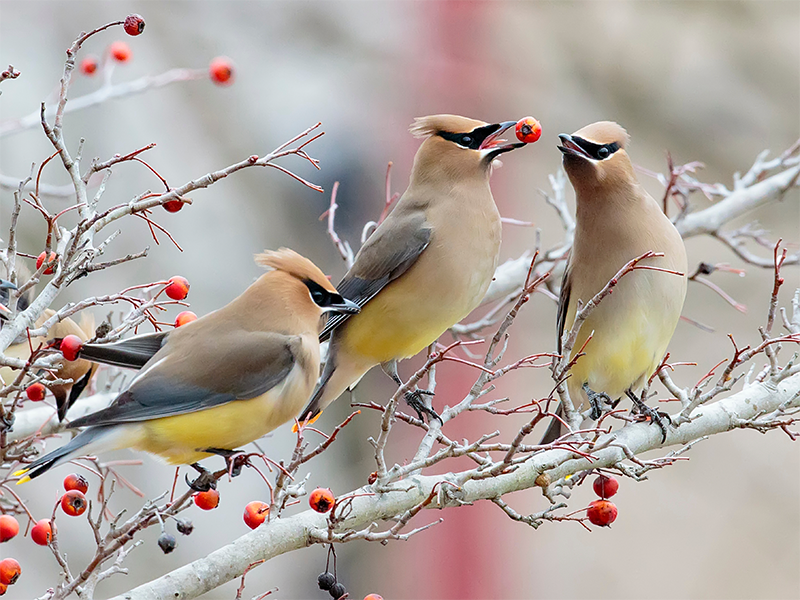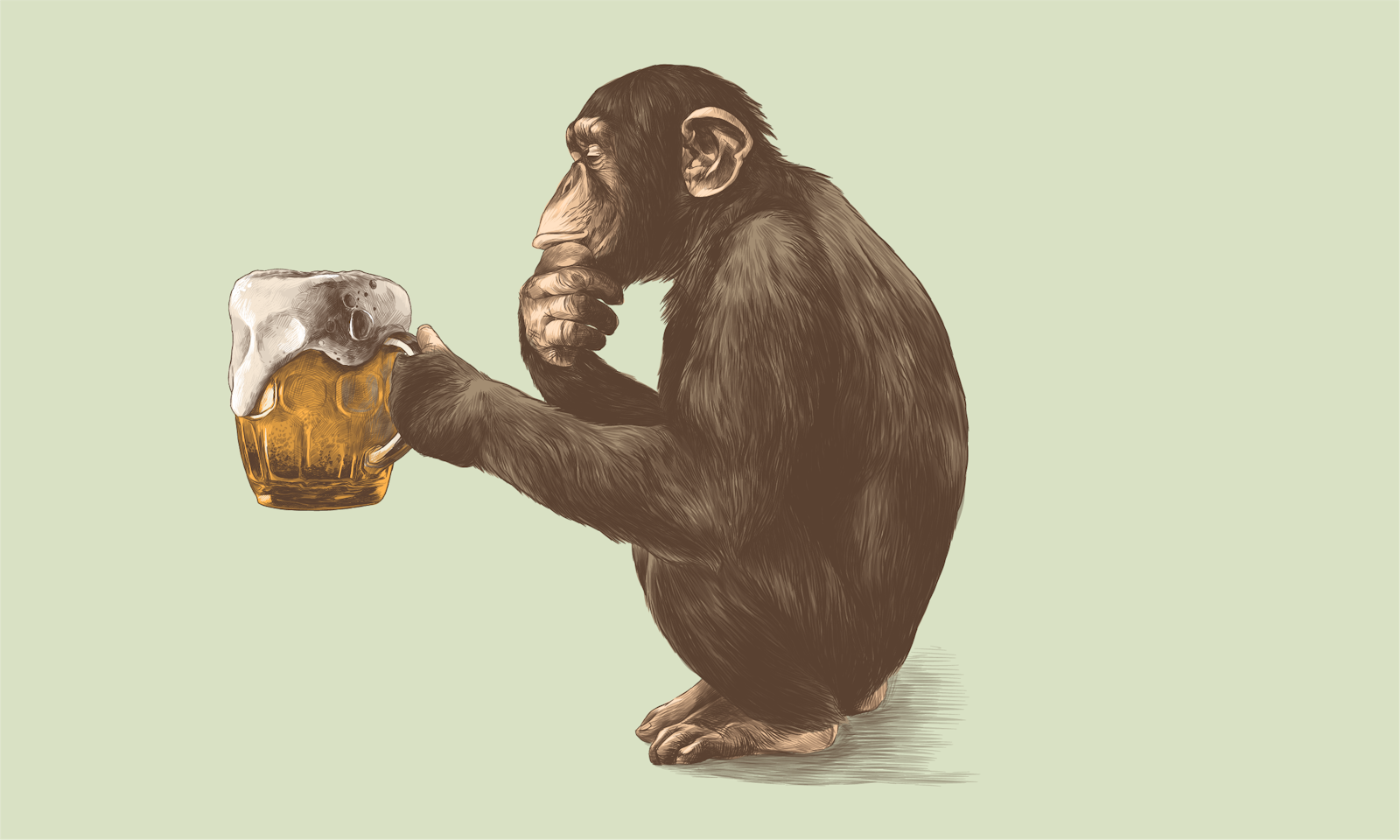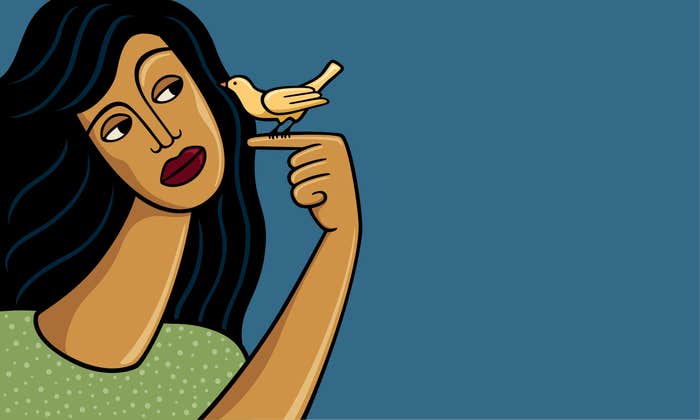Not long ago, residents of Gilbert, a small town in Minnesota, began calling the cops on a peculiar neighborhood nuisance. Cedar waxwings, wonderfully colored little birds, were “flying into windows, cars, and acting confused,” local law enforcement reported. The disturbance made headlines in places like NPR: “Minnesota Residents Call Police On Rowdy Drunk Birds.”
What was going on? Apparently, an unseasonable frost had caused the berries the waxwings feed on to ferment earlier than usual, and as a result, the police stated, some were getting a “little more ‘tipsy’ than normal.” The waxwings were at it again a few years later, in Texas, prompting the Houston Chronicle to run the headline, “Cedar waxwings are the drunken revelers of the bird world.” Rachel Richter, an urban wildlife biologist with the Texas Department of Parks and Wildlife, told a local news outlet, “Sometimes [the waxwings] tend to overindulge a little bit, which can get them intoxicated.”
Are these animals really getting wasted, and why?
In a 2012 paper in the Journal of Ornithology, Hailu Kinde, a veterinary microbiologist at the University of California, Davis, and his colleagues, conducted necropsies on several flocks of waxwings that were found dead after flying into windows, fences, and other obstacles. Their examinations “revealed that all birds had engorged themselves with over-ripe berries of the Brazilian Pepper Tree,” the authors wrote. They saw that the birds’ livers, which contained intoxicating levels of ethanol, had ruptured. “The cause of death in these birds,” Kinde and his colleagues wrote, “was trauma that resulted from colliding with hard objects when flying under the influence of ethanol.” One could make the argument that fruit trees near highways are responsible for a lot of animal-related car accidents.
Piotr Tryjanowski, an ecologist at the Poznan University of Life Sciences, doesn’t find stories like this surprising. Several species of migratory birds like waxwings, he points out, often consume fermented fruit, as ethanol-laden berries are not only sweeter but also provide the bird with more of an energy boost than their fresher counterparts. Such spirited berries make an encouraging cocktail for a bird hesitating to embark on a daunting migration. These fortified tonics would have similar effects on humans, too: “If you’re going on a hike, it helps to have chocolate in your rucksack and not just nuts, because while fat provides long term energy, sugar provides energy faster and, when combined with alcohol, it works even faster,” Tryjanowski told me over a zoom call. “This is especially true for birds, since their higher body temperature makes them get drunk faster, but sober up faster, too.”
It’s not just birds who seemingly enjoy hitting the bottle, so to speak. Hamsters lap up Everclear enthusiastically. Monkeys consume ethanol-laden fruit regularly, although their stomachs usually fill before reaching inebriating levels. In 1974, a reported 150 elephants broke into a brewery in West Bengal, India, and the 6,000 pound hulks went on a rampage that killed people. There are so many deer, seemingly plastered and generally “running amok.” And a moose was found drunk, stuck in a tree. There’s also the pet elk of the eccentric 16th-century Dutch astronomer Tycho Brahe to consider, as the elk met an unfortunate end falling down a flight of stairs in the nobleman’s castle after a night of binge drinking with his owner. Beyond the cautionary tale of animal endangerment, there is a glaring question: Are these animals really getting wasted, and why?

In a 2011 paper, researchers observed that rodents, primates, and flies will drink enough to reach high blood-alcohol concentrations, noting that, “they often display observable signs of intoxication.” Still, the variations in anatomy and digestive enzymes and apparatuses make it difficult to discern exactly what’s going on when these creatures are consuming ethanol.
More recently, researchers analyzed the genomes of 85 mammals to see how widespread the ability to metabolize ethanol might be. They reviewed chimpanzees, pen-tailed treeshrews, elk, elephants, and a variety of birds and bats. The amount of ethanol consumed along with the observable behavioral differences across mammals were wildly variable. Pen-tailed treeshrews, for example, consume enough ethanol to intoxicate a human, yet show no signs of intoxication. On the other hand, elks in Sweden exhibit signs of intoxication after simply feeding on a few rotting apples in autumn. Elephants actually turn out to be lightweights because they lack a crucial enzyme that metabolizes ethanol quickly. If dwarf hamsters were as a big as elephants, the furry rodents would drink them under the table, since they apparently have no trouble imbibing alcohol.
Even different species of the same order of creature, like bats, have considerably varying abilities to tolerate ethanol. Egyptian fruit bats have a hard time flying and echolocating after consuming a fruit with more than 1 percent ethanol, while Phyllostomid bats show no signs of intoxication even with blood alcohol concentrations that would make humans legally intoxicated. “What is clear,” the authors conclude, “is that the potential alcohol digestome varies widely among mammals to functional effect, and it is almost certainly erroneous to make inferences about one species based on another with divergent physiologies and ecologies.”
Still, there is the question of why animals would get drunk in the first place. The quickly available sugar might provide quick energy, but the overall evolutionary benefit to animals getting a little boozy is not at all clear. Tryjanowski says that “all the data in observations of animals drinking shows that” they are more likely to injure themselves, become more cavalier around predators, and that they are more likely to choose sub-optimal mates. An intoxicated animal seemingly rejects everything about adaptation: The creature literally becomes worse at living in its environment.
But just because the evolutionary reasons for animal tippling aren’t clear doesn’t mean they don’t exist. “There may be social and not just nutritional reasons for alcohol consumption,” says Robert Dudley, author of The Drunken Monkey: Why We Drink and Abuse Alcohol. “A study in Science about 10 years ago found that male fruit flies that have been recently rejected by a female are more likely to move to an area of the fruit with a higher ethanol concentration.” Are these tiny flies imbibing to soften the blow of sexual rejection?
A reported 150 elephants broke into a brewery in West Bengal, India.
A biologist at the University of California, Berkeley, Dudley spent a long time studying primates in Panama. He reports seeing intoxicated and emboldened spider monkeys going “bipedal and charging the comedor, opening the refrigerator, grabbing a loaf of bread, and storming out.” In The Drunken Monkey, Dudley also reiterates Darwin’s claim that one could attract African baboons with strong beer, and how Darwin once wrote his friend W.M. Moorsom about a monkey held captive in a pub by the owner who became a complete alcoholic (the monkey, although perhaps the pub owner, too).
Dudley’s so-called “drunk monkey” hypothesis states that, since fermentation not only amplifies the scent of the fruit but also signals the presence of digestible sugars, our evolutionary ancestors initially became fascinated with ethanol-laden fruit for nutritional reasons, and subsequently developed an attraction to its psychoactive effects. As a recent paper co-authored by Dudley states, “contemporary patterns of alcohol consumption … may derive from these ancestral associations between ethanol and nutritional reward,” while the “psychoactive and hedonic effects of ethanol may result in increased consumption rates.”
But regardless of why our animal ancestors started drinking, the consumption of alcohol might have been evolutionarily advantageous. “As every bar and restaurant proves every night, alcohol is an amazing aperitif,” Dudley says. “But it doesn’t just stimulate feeding, it also kills off microbes, thereby increasing health and reducing mortality.”
It may very well be the case that other animals started drinking for similar, nutritive reasons, only to develop a more social and hedonic attraction to ethanol later on. And perhaps there are tangentially adaptive reasons for animals drinking. While they may venture into new territories with lurking predators, they might also discover new habitats and food sources. And while they might choose sub-optimal mates under the influence, some species might have been too picky to begin with. “We’ve all thought about these possibilities,” Dudley confesses. “But who knows?” ![]()
Marco Altamirano is a writer based in New Orleans and the author of Time, Technology, and Environment: An Essay on the Philosophy of Nature. Follow him on Twitter @marcosien and Instagram @cocomarquito.
Lead image: Serafima Antipova / Shutterstock




























